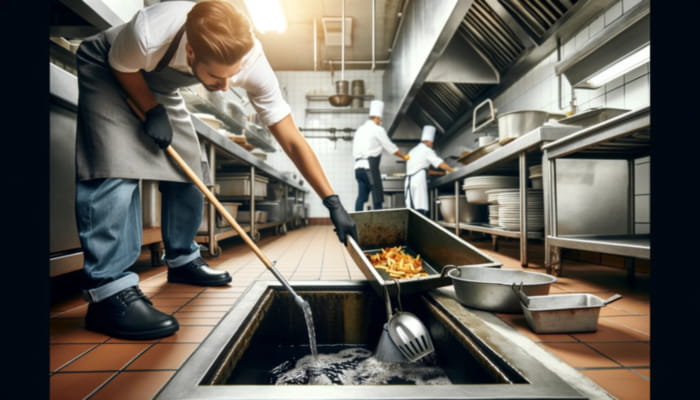The rhythmic sizzle of frying food, the aroma of spices wafting through the air, the satisfied smiles of hungry patrons – that’s the symphony of a successful commercial kitchen. But beneath the surface, another crucial dance unfolds, one involving fats, oils, and grease (FOG) and their silent partner, the often-overlooked yet essential grease trap. Neglected traps can lead to a cacophony of problems – blocked drains, foul odours, costly downtime, and environmental damage. Don’t let grease sabotage your culinary harmony! This comprehensive guide delves into the world of grease trap cleaning and maintenance, empowering you to ensure your commercial kitchen operates smoothly, safely, and in compliance with regulations.
Why This Guide Matters:
Maintaining your grease trap isn’t just a chore, it’s an investment in your business’s success. Consider these compelling reasons:
- Protect your business: Unmaintained traps lead to costly blockages, repairs, and potential fines, disrupting operations and impacting your bottom line.
- Maintain efficiency: Regular cleaning ensures optimal trap function, preventing backups and protecting your drainage system, saving you money on repairs and ensuring smooth operations.
- Safeguard the environment: Grease traps prevent harmful FOG from entering waterways, protecting our rivers, oceans, and delicate ecosystems.
- Stay compliant: Adhering to proper cleaning schedules is crucial to meet legal requirements and avoid hefty fines, keeping you on the right side of the law.
Demystifying Grease Traps:
- What are they? These plumbing superheroes intercept FOG from wastewater before it enters the sewer system. Imagine them as tiny sieves silently filtering out potential troublemakers.
- Why are they important? FOG solidifies and clogs drains, leading to backups, foul odours, and damage to your pipes. Think of it as a plumbing nightmare waiting to happen.
- How often do they need cleaning? Just like your car needs regular oil changes, your grease trap requires cleaning. The frequency depends on your business activities, typically ranging from 1-5 times per month. Imagine grease build-up as a slowly rising tide; regular cleaning prevents it from overflowing.
How to Clean a Grease Trap in London
Cleaning a grease trap is an essential task for any commercial kitchen in the London, as it prevents fats, oils, and grease (FOG) from clogging the drainage system and causing environmental damage. Here’s a step-by-step guide on how to clean a grease trap in compliance with UK regulations:
Preparation
- Gather Necessary Tools and Equipment: You’ll need rubber gloves, a gasket or lid opener, a large bucket or container for waste, a scraper, a large spoon or scoop, and a cleaning brush.
- Safety First: Ensure you wear protective clothing, including gloves and goggles, to prevent contact with harmful bacteria and FOG.
Cleaning Process
- Remove the Lid: Carefully open the grease trap lid using the gasket opener. Be gentle to avoid damaging any gaskets or seals.
- Inspect and Document: Note the grease level for compliance records. In the London, businesses must maintain records of grease trap maintenance for environmental health inspections.
- Remove and Dispose of the Contents: Use the scoop or spoon to remove the FOG and solid waste from the grease trap. Place this waste into your container. It’s important to dispose of this waste responsibly – in the UK, it must be done in accordance with the Environmental Protection Act 1990.
- Scrape and Clean the Trap: Use the scraper and brush to spotless the sides and lid of the grease trap. It’s important to remove all grease residues to ensure efficiency.
- Check and Clean the Screens and Parts: Remove any screens or filters and clean them separately, removing any FOG or food debris.
- Flush and Rinse the Trap: Once all components are clean, flush the trap with warm water to ensure all loose particles are removed. Be sure not to use any harsh chemicals that can harm the sewage system.
- Reassemble the Grease Trap: Put all components back in place, ensuring everything is fitted correctly to prevent leaks or damage.
- Record Keeping: Log the cleaning process, including the date and any observations, in your maintenance records. This log is essential for compliance with UK health and environmental standards.
Keeping Your Grease Trap Happy:
- Regular cleaning: Schedule routine cleanings with a professional service (think of them as your grease trap’s personal trainers). This ensures FOG doesn’t accumulate and cause problems.
- Monitor FOG levels: Regularly check the trap’s “oil gauge” to gauge FOG build-up (don’t worry, it’s not as messy as it sounds). This helps you schedule cleaning before things get greasy.
- Use the right products: Avoid pouring hot fats and oils directly down the drain (like throwing a wrench into the finely tuned system). Utilize FOG-intercepting products responsibly.
- Maintain your system: Address any leaks or damage promptly. Think of it as patching a hole in your boat before it starts taking on water.
Taking the Deep Dive:
- Commercial grease trap cleaning: Explore the various methods used by professional services, like the manual removal SWAT team, the high-powered vacuum truck brigade, and the eco-friendly bioremediation squad. Each has its strengths, and the best method depends on your trap’s design and needs.
- Grease trap emptying and disposal: Remember, collected FOG isn’t just waste, it’s a resource! Learn about the legalities and responsible disposal methods, like recycling into biodiesel or converting it into animal feed. Imagine giving FOG a second life and contributing to a circular economy.
- Grease trap maintenance tips: Treat your trap like a valued employee! Keep the lid closed, scrape, don’t pour, use grease interceptor devices, and monitor it regularly. These small steps go a long way in keeping your trap happy and efficient.
Beyond the Basics:
- Grease management systems: Upgrade your grease trap game! Explore advanced systems like automated dosing units and in-line separators for enhanced FOG capture and efficiency. Imagine having a high-tech filtration system working silently behind the scenes.
- Ensure your grease trap: Make sure you have the right trap for the job! Verify the size and type are suitable for your business activities and wastewater flow. It’s like having the right tool for the right task.
- Install and maintain: Partner with a qualified professional for proper installation and ongoing maintenance. Think of them as your grease trap’s trusted mechanic, ensuring it runs smoothly.
What chemicals are used to clean grease traps?
Chemicals used to clean grease traps primarily include enzymes and bacteria. Enzymes are catalysts that speed up the breakdown of grease, turning it into water and carbon dioxide. Bio-enzymatic cleaners actually contain live bacteria that digest grease, effectively removing clogs and maintaining grease trap efficiency. These chemicals are eco-friendly and safe for pipes and drains.
What happens if you don’t clean a grease trap?
If a grease trap is neglected, it can lead to serious plumbing problems. Grease and food particles build up and harden, blocking the flow of wastewater. Foul odours may emanate due to rotting organic matter. Negligence also welcomes pests and could result in potential health risks besides costly repairs.
How much does grease trap cleaning cost?
In London, the cost of grease trap cleaning varies based on the size and condition of the trap. On average, you may expect to pay anywhere from £90 to £200. However, this price can increase significantly if the trap hasn’t been well-maintained.
Remember:
- Environmental impact: Grease pollution affects our waterways and ecosystems. Responsible grease trap management contributes to a healthier planet. Imagine being a champion for a cleaner environment, one delicious meal at a time.
- Training your staff: Empower your team! Educate your staff on proper FOG disposal practices to minimize grease entering the drainage system. Imagine your staff as grease trap allies, working together for a cleaner kitchen and environment.
- Emergency preparedness: Be ready for anything! Have a plan in place for grease trap overflows or blockages to minimize disruption and environmental impact. Imagine being a calm and collected captain navigating any greasy storm.
By implementing these insights and seeking professional guidance, you can ensure your grease trap becomes a silent guardian of your kitchen’s success. Remember, a well-maintained grease trap isn’t just good for business, it’s good for the environment and the community. It’s about creating a symphony of success, where delicious food, happy customers, and environmental responsibility harmonize perfectly.


